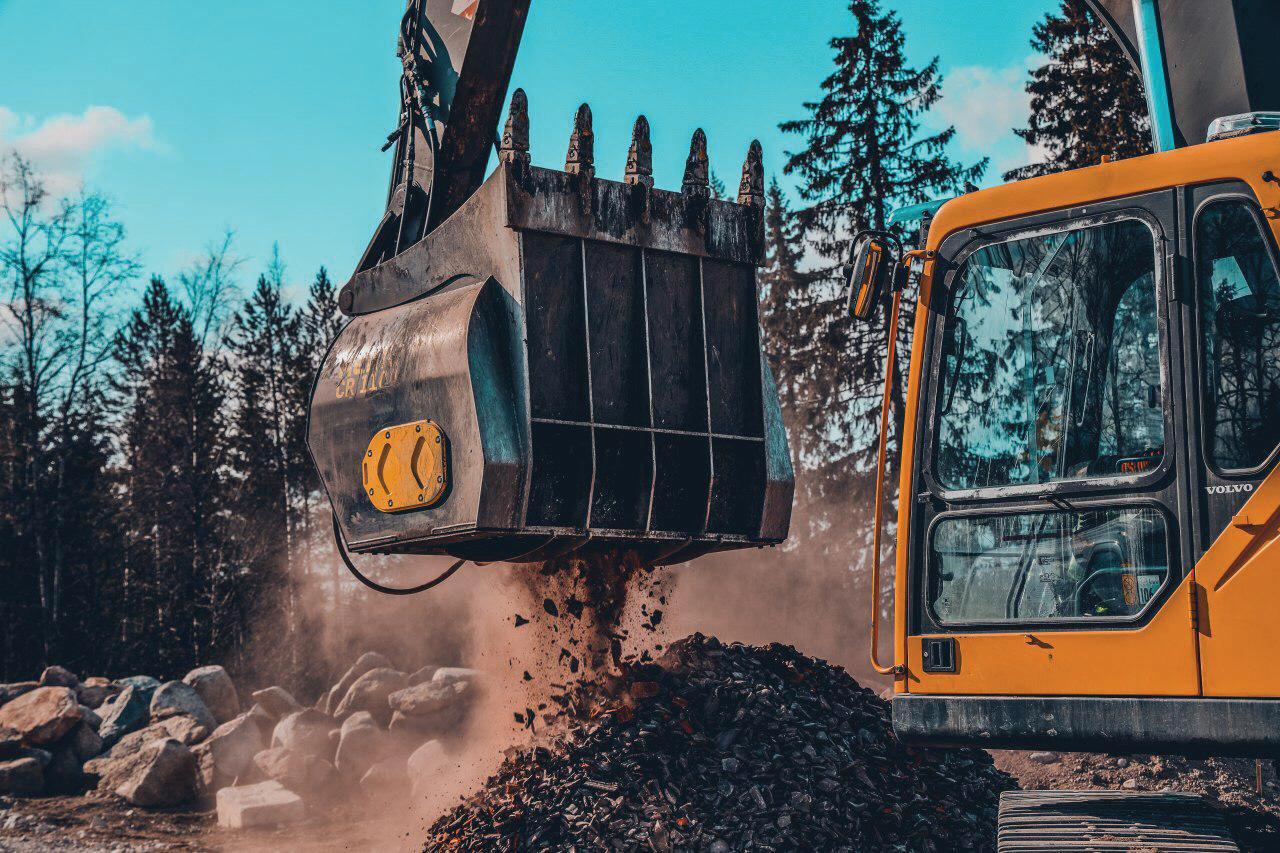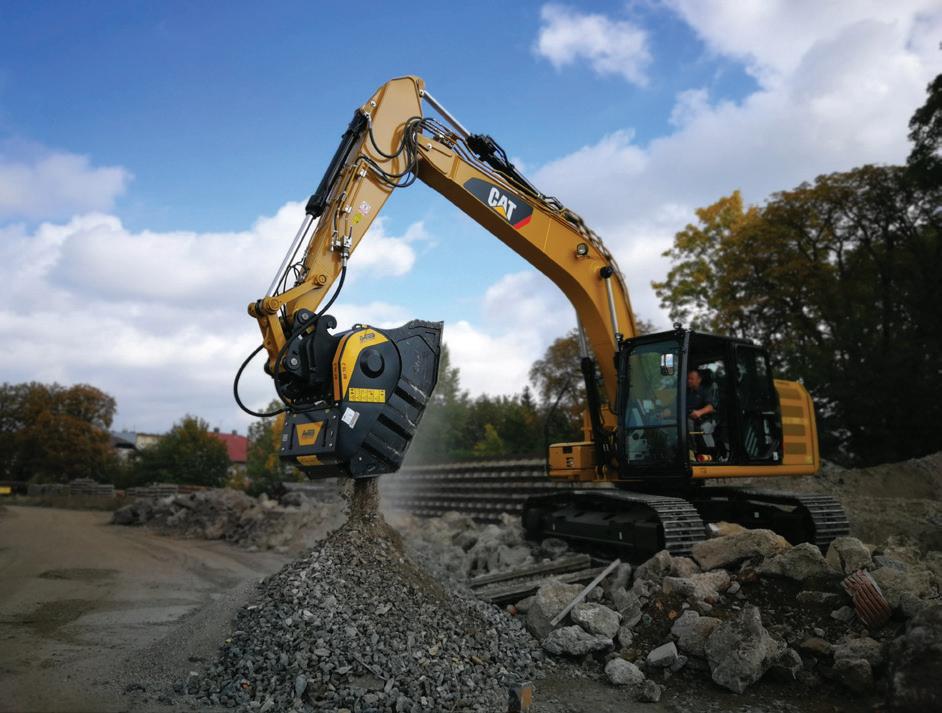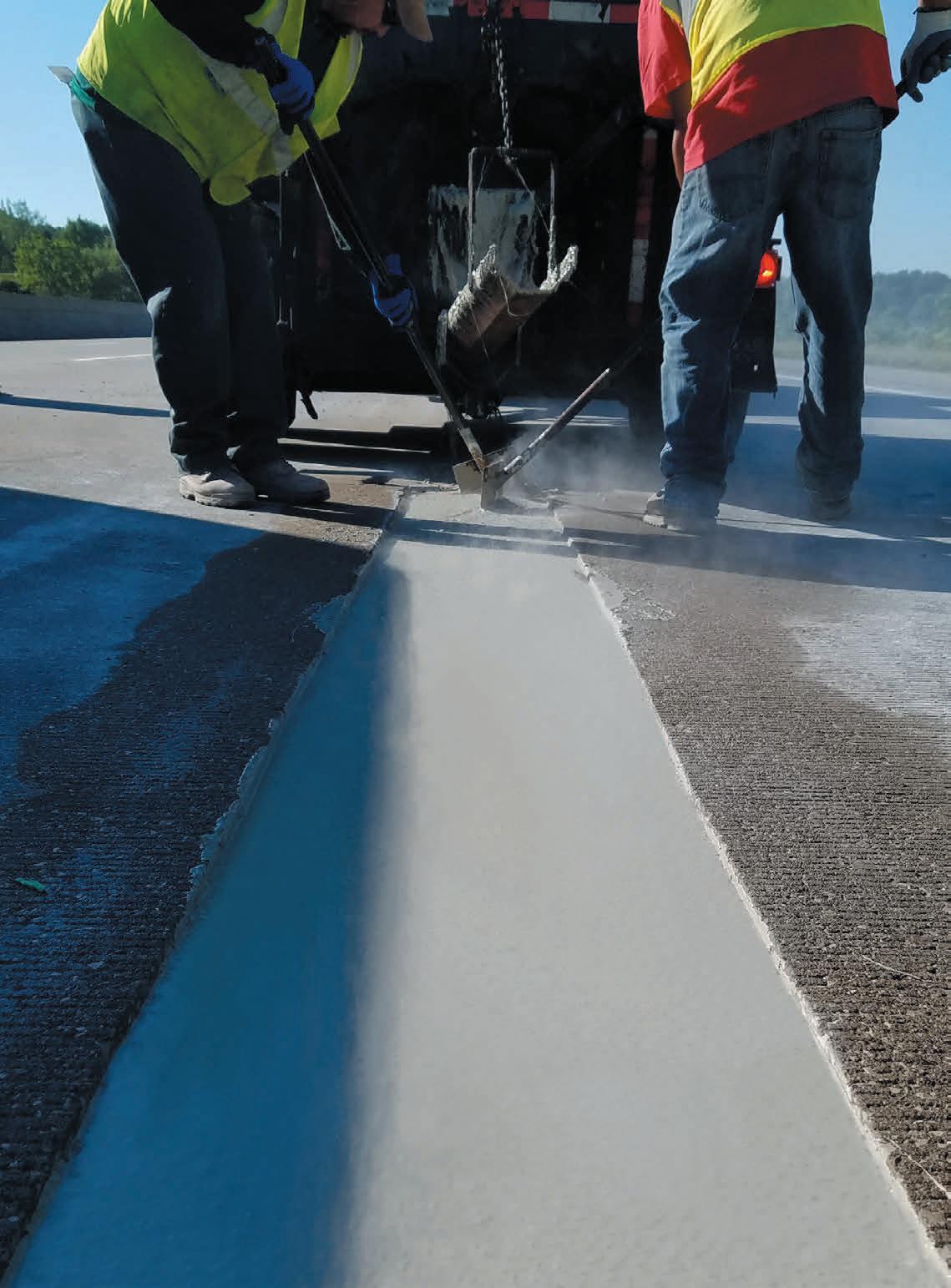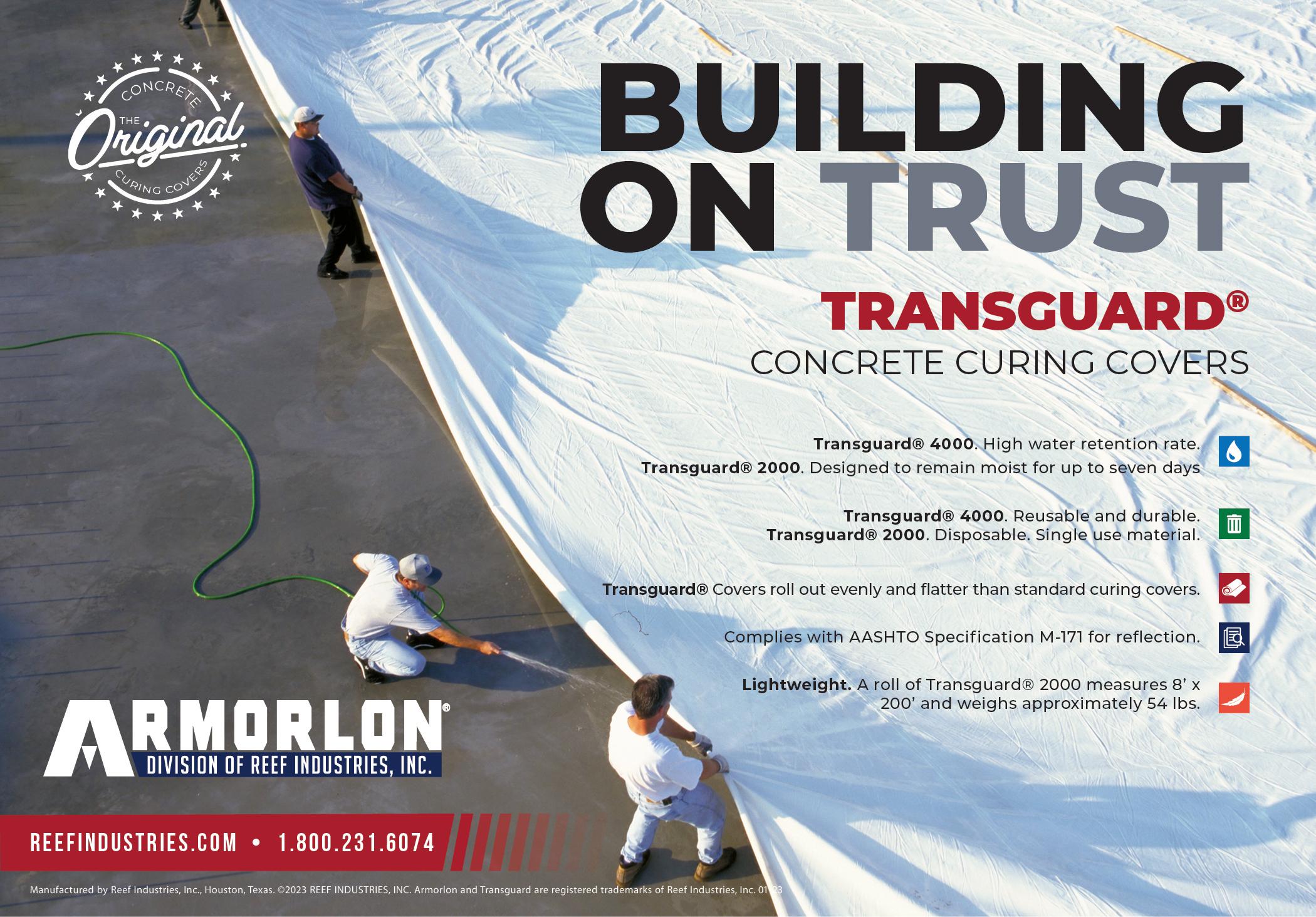
7 minute read
Concrete Processing Attachments Enhance Recycling Savings
Attachments allow concrete to be economically recycled on site, saving on aggregate, trucking and dedicated crushing plants.
Equipment used to process concrete on site typically includes various kinds of crushers, whether it be a jaw crusher or a crusher plant, or pulverizers, hammers and universal processor attachments. Crusher and shaft screener buckets and drum cutters can also be used to accurately size concrete materials. According to MB Crusher, crusher buckets reduce hauling fees by crushing the material directly on site for immediate reuse.
Many attachments can be used for processing concrete on a jobsite. “The product that is most useful for this process will be determined by the specific task to be accomplished and the jobsite conditions,” says Rich Elliott, product and application specialist, Epiroc. “Taking down a concrete structure (building, bridge, foundation, etc.) may require a different attachment than processing concrete that is in a pile.”
For example, deconstruction of a building, bridge or structure will be best suited for a multi-processor or concrete cracking attachment. Yet, other contractors may prefer a hydraulic breaker for this task.
Understand options and the tradeoffs before choosing the attachment. “We have the Combi Cutter with three separate jaw sets,” says Elliott. Universal, steel and pulverizer jaw sets can be changed in 30 minutes or less on site to easily adapt to the job requirements. “We also offer a Concrete Buster [for] where noise pollution and vibration are an issue when working on structures and/ or foundation demolition. There is the Demolition Pulverizer, which has a single moving jaw and is configured as a straight jaw, and the Bulk Pulverizer, which has a curved jaw like a bucket.”
No single attachment is the best solution for every job. “This is completely dependent on the end use for the concrete,” says Chad Wood, Genesis product development engineer. “Are you feeding an on-site crusher, or pulverizing concrete to a reusable size?
“If feeding a crusher, a dedicated concrete cracker-style tool will most efficiently get the concrete down to a size that you can feed a crusher or haul off site,” he points out. “If you are processing concrete to a size that is reusable on site, then a dedicated pulverizer or linkage pulverizer would be your tool of choice. These tools would downsize the concrete into 3-in. minus, if necessary, as well as make clean rebar that can be taken directly to a recycling center.”
MULTI-PROCESSORS VS. DEDICATED ATTACHMENTS
When choosing between a dedicated
In many applications, mobile crushing buckets are an alternative to mobile crushing plants. Throughput varies and is a function of the material hardness and density. REMU pulverizer attachment and a universal processor, consider the pros and cons associated with each choice. According to Wood, the dedicated pulverizer offers a larger jaw size, more power and a lighter weight in some instances. The universal processor offers more versatility in processing multiple types of material. Without the universal processor, a contractor may need multiple attachments or machines on a site, which may be difficult on small sites or for smaller contractors. “There is a trade-off with a universal processor,” says Wood. “To have the versatility of being able to process multiple materials with one tool, you give up some performance and productivity. Universal processors typically will have a smaller jaw or less power than a similar-size dedicated tool.” Elliott adds, “Typically, for the same
size carrier that a dedicated pulverizer would fit on, it would have a larger jaw opening to allow larger pieces of concrete.”
It makes a difference whether the attachment is being used to pull a concrete structure apart or process concrete that has been piled up. “A dedicated pulverizer is typically best used for material that is loose (already on the ground),” says Elliott. “These have one stationary jaw and one moving jaw. They come in two different styles — a straight jaw configuration and one with a curved jaw to assist with grabbing concrete that is in a pile.
“The universal pulverizer is a better product to use for demolition of concrete structures because there are two moving jaws,” he continues. “If one jaw contacts the material first, the other jaw will quickly catch up. Once the pressure is equalized, then both jaws will start to crush/cut/ pulverize the material.”
Separating concrete and rebar is possible with both the dedicated pulverizer attachment and the universal processor with a pulverizer jaw set. “If you have a concrete cracker-style jaw set installed in a universal processor, you may not be able to separate all the rebar as this type of jaw typically makes larger chunks of concrete,” says Wood.
Note that the pulverizer should not be relied upon to remove all metal from the concrete. “There may be small pieces of rebar that may get mixed into the concrete and a magnet would be helpful to gather the smaller steel pieces,” says Elliott.
It’s worth noting that hydraulic-powered attachments are not the only solutions for processing concrete. “Mechanical pulverizers can be very effective at downsizing concrete and can work very quickly compared to a hydraulically powered attachment,” Wood states. “Also, they are typically a significantly lower upfront investment cost. The downside to a mechanical pulverizer is it relies on the bucket cylinder and linkage of the excavator for its power, which is less than the power generated by a hydraulically powered pulverizer. This limits the size and strength of material you can process with a mechanical pulverizer.”
No matter which attachment is selected, it needs to be sized and matched to the carrier and jobsite conditions. “The specific attachment size will be determined by the size of the carrier that the attachment will
be mounted to, as well as the thickness and reinforcement inside of the concrete that needs to be processed,” says Elliott.
“This may also be a factor in the hydraulic kit that is on the specific carrier being used,” he points out. “The Combi Cutter (multiprocessor), Concrete Buster (concrete cracker) and Demolition Pulverizer all require a bidirectional auxiliary circuit and rotation circuit. The Bulk Pulverizer

Crusher bucket attachments allow concrete to be accurately sized and reused as aggregate on smaller jobsites, requiring minimal investment in support equipment. MB Crusher
Sealing concrete cracks, joints, and other distresses with a rigid repair material often fail as they grow brittle and break over time. The ideal solution provides both strength and flexibility. TechCrete™ is a highly flexible concrete repair material that not only adjusts with the pavement but delivers the strength to support heavy loads, and the durability to resist cracking, delamination, and spalling. Have your concrete and repair it, too, with TechCrete™. The most advanced, flexible, long-term repair solution for concrete.
Nationwide sales, service, and rentals. Learn more at crafco.com/sales

will require a bidirectional circuit also, but can be fitted with or without the rotation device.”
SIZING THE PRODUCT
Using pulverizing attachments is usually the first step in recycling concrete on the jobsite.
“The pulverizer does not produce any specific size material,” says Elliott. “The use of this product is strictly to reduce the size of concrete to manageable sizes and/or to separate the reinforcement from the concrete. This means that the material will vary in size from dust on up.
“If there is a specific size material than can be used on the same jobsite, then a crusher bucket can be used to process the larger pieces of concrete to a specific size,” he notes. “You could also use a bucket screener to separate material of a specific size or smaller.”
According to Wood, “With a dedicated pulverizer or a universal processor with a pulverizer jaw set installed, you can achieve 3- to 4-in. minus material. This may take some additional time to achieve as you may need to take smaller bites of the concrete each time.”
Portable crushers, crushing buckets and screening attachments are necessary to produce accurate aggregate specifications on the jobsite. While production requirements on larger jobsites may require a portable crushing plant and the necessary support equipment, crusher buckets can prove an economical alternative on smaller projects.
Crusher bucket attachments allow concrete to be accurately sized and reused as aggregate on smaller jobsites with minimal support equipment.
“The advantages of bucket crushers are they are compact and can easily be transported and installed on any carrier with an auxiliary circuit,” says Elliott. “If the material can be used on site, this will reduce transport costs. Limitations are they will not be able to produce as much as a portable crusher. Bucket crushers can produce material size from 3/4 to 6 in.”
With the right attachments, you can set up a cost-effective concrete recycling operation on even small or confined jobsites, saving the cost of trucking in expensive aggregate while reducing the amount of construction debris leaving the jobsite.
Curt Bennink has been writing about the construction industry for over 20 years.
Find crusher bucket benefits and limitations with this article at
https://CONC.me/ktukqt











